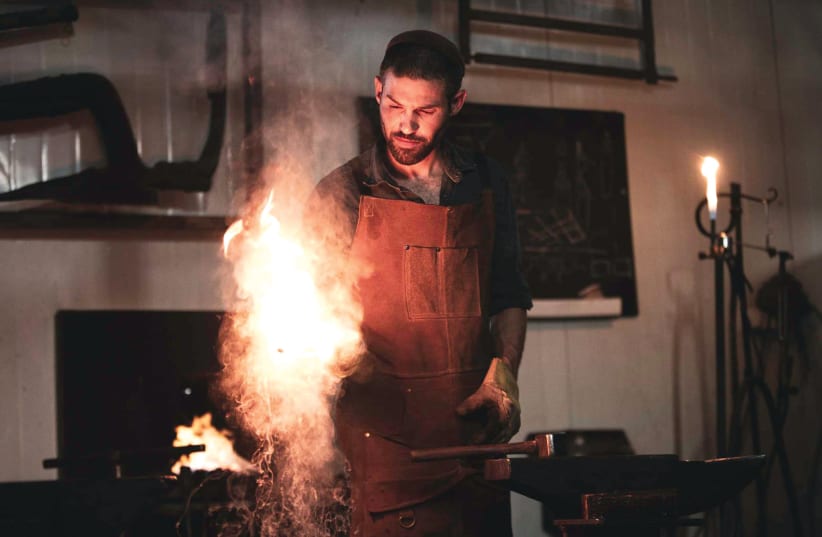There are innumerable ways to express artistic talents and unusual media whereby to give vent to the muse. Meir Sharon, 30, a gifted young Israeli, always had a knack for art; even as a child, he enjoyed creating things. He grew up in Karnei Shomron, a small settlement in Samaria, and in the IDF he used his talents to design his unit’s camouflage equipment.
Due to an accident during his IDF service, he was laid up for a number of weeks. It was his father who suggested he apprentice at the metal works of a friend in Ofra, Yosie Gur Arie, and the opportunities of bending and sculpting the hard material was ignited. Sharon studied industrial design at Ariel University (this time at the suggestion of his mother, an artist herself) but already then, he started his pioneer work in producing original artifacts and home design forging metal.
Getting into blacksmith work
“A friend asked me if I could make a stairway banister for his mother’s new house. I agreed, although I didn’t have a clue how to go about it,” he admits. He spent many hours designing and experimenting, working out a way to do it, and the finished product was very well received. Then he worked on a metal gate with his own artistic design, and from then on he started getting orders.
“I really had to begin from scratch for most of my work,” says the artist. “Ordinary traditional blacksmith equipment didn’t always suit my needs. I needed special hammers and pliers which I designed myself. The basic anvil on which you pound out hot metal isn’t something you can buy in the market.” Sharon needed several anvils. He found one thrown behind a garbage dump, and another he inherited from an old blacksmith who closed his business. A third anvil came back with his parents from Hungary where they toured last year.
Another challenge for the artistic blacksmith was producing products with various hues of blue, yellow, gold, deep red or grays. He learned to manipulate the amount of firing each item undergoes to obtain just the right coloring. Moreover, he learned early on that in order to ensure the lasting quality of his works and to prevent rusting, all artifacts must be covered with laque, whether his own creations or those of his clients and students.
Sharon is not just a craftsman. He also enjoys teaching. He has small groups that come to his studio in Itamar to learn his craft by observing and by doing. Moreover, his studio has become a popular site for visits from groups like employee outings, birthday parties, celebrations and tours of all sorts. The crux of each visit is not only to see what can be done manipulating metal but also to engage each participant in making something themselves.
My daughter-in-law recently celebrated a turning-point birthday, and all her many children and grandchildren took her to Sharon’s studio as a surprise. After receiving basic explanations on how one works with metal and voting on what they wanted to create as a family, the entire group, under the artist’s direction, crafted a beautiful handmade candelabrum which the family will use now and forever and thereby commemorate the event.
Sharon has directed other groups to create candlesticks, metal wall hangings, decorative bottle openers, mezuzot, key hangers, coat hangers, and many other items with their individualized, long-lasting stamp on it. One popular item that people with rheumatism like to order is a bracelet made of hammered copper that some believe alleviates the symptoms. The Tourist Department of the Shomron (Samaria) has put Sharon’s studio on its list of recommended sites to visit.
However, he is especially proud of his entrance into the high school yeshiva world, where he gives a regular class on metalwork to a select group of youngsters for three- to four-hour sessions in Itamar. He himself studied there 15 years ago. “This class is especially suitable for kids who have a lot of energy, who can hammer out a rod of burning metal and turn it into something useful and attractive,” he says. At the recent Bezalel School of Art’s bazaar, he led a workshop on metalwork as part of the school’s branch on ancient crafts.
Now that he has established a name for himself, Sharon is starting to look into an additional direction for his artistic expression. He is beginning to combine metal artifacts with wood and natural stone, another durable and local element not easy to work with but with stunning results. “My items recall traditional Eretz Yisrael crafts,” declares Sharon, who is definitely deeply implanted in his homeland, as he uses the material at hand. “I feel that more than my art is a expression of craft, it is an expression of the heart,” he concludes.
Meir and his wife, Talia, live in Esh Kodesh, a young settlement in the Shomron where they are bringing up five children and are very active members of their community. He is quite humble about his innovative work as an artistic blacksmith and his breakthrough in a unique field of art., where only the sky is the limit. ■

